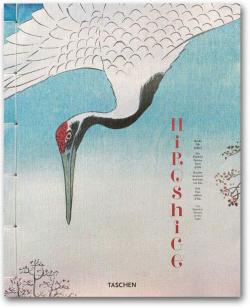Hiroshige. One Hundred Famous Views of Edo

Taschen, 2008, 294 pages, Japanese binding & bookcase £80.00, ISBN: 978-3-8228-4827-2
Review by Sir Hugh Cortazzi
Hiroshige and Hokusai are probably the two Japanese artists most famous in the west. They had a significant influence on the Post-Impressionists including Van Gogh, Monet and Whistler and on the Japonisme movement in European art in the latter part of the nineteenth century.
The publication of this sumptuous publication is timely. This year is the 150th anniversary of the first treaties with the five leading western powers (the USA, the Netherlands, Russia, Britain and France [not Italy as the introduction states]) which provided for the opening in 1859 of diplomatic and trade relations. The process had begun with the arrival of Commodore Perry’s “back ships” in 1853, but 1858 saw the real break-through. The British Treaty with Japan signed at Edo on 26 August 1858 was called “The Treaty of Yedo” (Yedo being a spelling of Edo used by some foreigners at that time).
Hiroshige’s hundred views of Edo were produced in the years 1856-1858 and provided a panorama of the sights in the capital. They are all upright or vertical prints in the size termed o-ban in Japanese. The prints which are kept by the Ota Museum in Tokyo are all from the first printing and as they have been very well preserved the colours are authentic and have not faded as so many other sets have faded. As the introduction points out the prints represent a cooperative effort between the artist, the woodblock cutter and the printer who applied the colours.
Although these prints are described as one hundred views there were in fact a total of 120. All of these have been reproduced in this book in full colour and the original size. Each plate is accompanied by a full description and explanation. There is an informative introduction in English, French and German. The book is bound in traditional Japanese style and comes in a handsome case illustrated in colour.
The prints were generally made to look like paintings. They functioned like modern colour picture postcards in the sense that they were intended as souvenirs for visitors to particular beauty spots, shrines and temples. With increasing affluence Japanese at the end of the Edo period had begun to travel whenever they could, but before there was any wheeled traffic journeys even of a short distance were time consuming.
In a number of prints elements of western style perspective were used. Western art techniques had been imported into Japan during the Edo Period (1600-1868), despite Japan’s strict seclusion policy. In some the artist has adopted the traditional Japanese birds-eye view. The most striking feature to the western eye is, however, the way in which pictures were composed to draw particular attention to certain features or points in the picture. This element in Japanese prints had a particular resonance for Post-Impressionist artists. The season plays an important role in some but not all the prints. Spring is depicted in 42 prints, summer in 30, autumn in 26 and winter in 20 including some memorable snow scenes. Artists were forbidden to depict Edo castle, the palace of the shogun. As a result there is a hole in the middle of Edo!
Utagawa Hiroshige (1797-1858) sometimes known as Ando Hiroshige was the son of a samurai official in Edo in charge of fire-fighting. After his parents died when he was only twelve years old he studied art under Utagawa Toyohiro and became an ukiyo-e artist. He adopted techniques from other schools and developed his own style. At first he specialized in depicting attractive courtesans but inspired by one of Japan’s greatest artists Katsuchika Hokusai (1760-1849) he specialized in landscapes and nature subjects. His most famous series is the “Fifty-Three Stations on the Tōkaidō” (Tōkaidōō gojūsan tsugi), but the hundred views of Edo deserves at least equal status.
Anyone interested in Japanese landscape prints and in Hiroshige or who wants an artistic view of the sights of Edo at the time the Treaties were signed 150 years ago will want to possess this luxurious volume.

